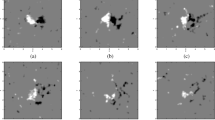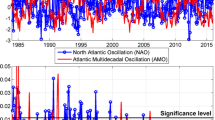Abstract
In the measurements of VLF electric fields with the Pioneer Venus spacecraft in sunlight, spin synchronized signals often dominate over the naturally generated emissions. We present a method to separate natural emissions from the several possible sources of noise. Our major objective by this method is not to remove all spin modulation, but to effectively subtract the background noise caused by the identifiable noise sources. Examination of the data shows that the background spin synchronized noise is quite sensitive to ϑ(n), the angle between the sense axis and the solar direction. We model the observed data asy(n)=w(n)t(n)f(ϑ(n))+x(n), wheref(ϑ) represents the phase response of the background noise andx(n) is the estimated natural emissions.t(n) andw(n) are the long-term trend component and time- and phase-independent component of the intensity of the background noise, respectively. The method to decomposey(n) is based on the Bayesian approach which has been recently applied to various inversion problems such as nonstationary time series modeling and image reconstruction. In this procedure, the estimated parametersw(n),t(n),f(ϑ), andx(n) can be determined automatically. We will describe the Bayesian scheme and its application to the Pioneer Venus VLF electric field data.
Similar content being viewed by others
References
Akaike, H. (1980). Likelihood and the Bayes procedure (with discussion),Bayesian Statistics, 143–165, University Press, Valencia, Spain.
Gersch, W. and Kitagawa, G. (1988). Smoothness priors in time series,Bayesian Analysis of Time Series and Dynamic Models (ed. J. C. Spall), 431–476, Marcel Dekker, New York.
Grubbs, F. E. (1969). Procedures for detecting outlying observations in samples,Technometrics,11, 1–21.
Higuchi, T. (1991a). Frequency domain characteristics of linear operator to decompose a time series into the multi-components,Ann. Inst. Statist. Math.,43, 469–492.
Higuchi, T. (1991b). Method to subtract an effect of the geocorona EUV radiation from the low energy particle (LEP) data by the Akebono (EXOS-D) satellite,Journal of Geomagnetism and Geoelectricity,43, 957–978.
Higuchi, T., Kita, K. and Ogawa, T. (1988). Bayesian statistical inference to remove periodic noise in the optical observations aboard a spacecraft,Applied Optics,27, 4514–4519.
Ishiguro, M. and Arahata, E. (1982). A Bayesian spline regression,Proc. Inst. Statist. Math.,30, 29–36 (in Japanese).
Kita, K., Higuchi, T. and Ogawa, T. (1989). Bayesian statistical inference of airglow profiles from rocket observational data: comparison with conventional methods,Planet Space Sciences,37, 1327–1331.
Kitagawa, G. (1979). On the use of AIC for the detection of outliers,Technometrics,21, 193–199.
Kitagawa, G. (1987). Non-Gaussian state space modeling of nonstationary time series (with discussion),J. Amer. Statist. Assoc.,79, 1032–1063.
Kitagawa, G. and Akaike, H. (1982). A quasi Bayesian approach to outlier detection,Ann. Inst. Statist. Math.,34, 389–398.
Russell, C. T. (1991). Venus lightening,Venus Aeronomy, 317–356, Kluwer Academic Publishers, Dordrecht.
Scarf, F. L. and Russell, C. T. (1988). Evidence of lightning and volcanic activity on Venus: Pro and Con,Science,240, 222–224.
Scarf, F. L., Taylor, W. W. L., Russell, C. T. and Elphic, R. C. (1980). Pioneer Venus plasma wave observations: the solar wind interaction,Journal of Geophysical Research,85, A13, 7599–7612.
Silverman, B. W. (1984). Spline smoothing: the equivalent variable kernel method,Ann. Statist.,12, 898–916.
Silverman, B. W. (1985). Some aspects of the spline smoothing approach to non-parametric regression curve fitting (with discussion),J. Roy. Statist. Soc. Ser. B,47, 1–52.
Strangeway, R. J. (1991). Plasma waves at Venus,Space Science Review,55, 275–316.
Tietjen, G. L. and Moore, R. H. (1972). Some Grubbs-type statistics for the detection of several outliers,Technometrics,14, 583–597.
Tsay, R. S. (1986). Time series model specification in the presence of outliers,J. Amer. Statist. Assoc.,81, 132–141.
Tukey, J. W. (1977).Exploratory Data Analysis, Addison-Wesley, Reading, Massachusetts.
Wahba, G. (1975). Smoothing noisy data with spline functions,Numer. Math.,24, 383–393.
Wahba, G. (1990).Spline Models for Observational Data, Society for Industrial and Applied Mathematics, Philadelphia, Pennsylvania.
Wahba, G. and Wold, S. (1975). A completely automatic French curve—Fitting spline functions by cross validation,Comm. Statist.,4, 1–17.
Author information
Authors and Affiliations
About this article
Cite this article
Higuchi, T., Crawford, G.K., Strangeway, R.J. et al. Separation of spin synchronized signals. Ann Inst Stat Math 46, 405–428 (1994). https://doi.org/10.1007/BF00773508
Received:
Revised:
Issue Date:
DOI: https://doi.org/10.1007/BF00773508




